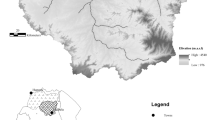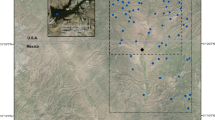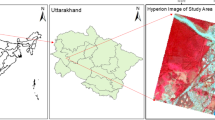Abstract
In environmentally sensitive and large coastal dune systems, identification and mapping of favourable (sandy), and unfavourable (scrub rich) habitats form the key to coastal conservation and management. In highly mixed floral environments, however, such an identification is difficult with low resolution multispectral imagery. In such cases, spectral unmixing is useful to resolve the “mixed pixel” effects. The Kenfig NNR (National Nature Reserve), South Wales. UK, bestowed with high biodiversity, is facing loss of successionally young slack habitats due to dune stabilisation and vegetation succession. To map such habitats, linear spectral unmixing of airborne MSS (CASI-Compact Airborne Spectrographic Imager) data was performed using the Constrained Least Square (CLS) method, and the sub-pixel proportions of the spectral end members viz. sand, vegetation and shade/moisture were defined. Comparison of the estimated fractions with the growth forms of the dominant vegetation species Salix repens (Creeping willow) with classified digital aerial photographs shows a positive correlation, thus giving us confidence in the mixture modelling technique. Apart from aiding in conservation management, such a fuzzy classification of multi-date imagery helps to delineate sandy and vegetated areas for change detection and landscape/ habitat succession studies.
Similar content being viewed by others
References
Anger, C D, Babey, S K, and Adamson, R A, (1990). A new approach to imaging spectroscopy. Proceedings of SPIE, 72: 72–86.
Babey, S K, and Soffer, R J, (1992). Radiometric calibration of the Compact Airborne Spectrographic Imager (CASI). Can. J. Remote Sensing. 18:233–242.
Baker, W L, Honaker, I I, and Weisberg, P J, (1995). Using aerial photography and GIS to map the forest-tundra ecotone in Rocky Mountain National Park, Colorado, for global change research. Photogrammetric Engineering and Remote Sensing, 61:313–320.
Bryant, R G, (1996). Validated linear mixture modelling of Landsat TM data for mapping evaporite minerals on a playa surface: methods and applications. Int. J. Remote Sensing, 17: 315–330.
Dargie, T C D, (1995).Sand Dune Vegetation Survey of Great Britain -A national inventory, Part 3: Wales. JNCC report, U.K. pp 26–32.
Davies, A J D, (1995). Greening of Kenfig Burrows. BSc Thesis. University of Wales Swansea, UK.
Garcia-Haro, F J, Gilabert, M A, and Melia, J, (1996). Linear spectral mixture modelling to estimate vegetation amount from optical spectral data. Int. J. Remote Sensing, 17: 3373–3400.
Hill, C J, (1995). Monitoring and prediction of ecological succession by measurement of functional characteristics of the soil. Ph.D Thesis. (London: University of East London).
Hurford, C, (1994). A survey to monitor the fen orchidLiparis loeselii in dune slack ND6 at Kenfig NNR, October 1992. A report by the Countryside Council for Wales, UK.
Jones, P S, (1989). Ecological and physiological studies of sand dune slack vegetation, Kenfig Pool and Dunes Local Nature Reserve, Mid-Glamorgan, Wales, U.K. InPerspectives in Coastal Dune Management, (Eds. F Van der Meulen, P D Jungerius and I H Visser). The Hauge: SPB Academic Publishing, pp. 297–303.
Jones, P S and Etherington, J R, (1992). Autoecological studies on the rare orchidLiparis loeselii and their application to the management of dune slack ecosystems in South Wales. In Coastal Dunes(Eds.: R W G Carter, T G F Curtis and M J Sheehy-Skeffington. Rotterdam: Balkema, pp. 299–312.
Jones, P S, (1993), Ecological and hydrological studies of dune slack vegetation at Kenfig NNR, Mid-Glamorgan. Ph.D. Thesis. Cardiff: University College of Wales.
Leberl, F W, Maurice, K, Thomas, I K, Millot, M, (1994). Automated radar image matching experiment. ISPRS J. Photogrammetry and Remote sensing, 49:19–33.
Miller, R L, and Cruise, J F, (1995). Effects of suspended sediments on coral growth-evidence from remote sensing and hydrologic modelling.Remote Sensing of Env. 53: 177–187.
Potts, E A, (1968). The geomorphology of the sand dunes of South Wales. Ph.D Thesis. Swansea: University College of Swansea.
Settle, J J, and Drake, N A, (1993). Linear mixing and the estimation of ground cover proportions. Int. J. Remote Sensing, 14: 1159–1177.
Shanmugam, S and Barnsley, M J (1997). Quantifying landscape/ecological succession in a coastal dune system using sequential aerial photography and GIS. InCOASIGIS’97-The next millennium (Eds. D R Green and G Massie). Scotland.
Shimabukuro, Y E and Smith, J A (1991). The least-squares mixing models to generate fraction images derived from remote sensing multi spectral data. I. E.E.E. Trans. Geoscience and Remote Sensing, 29: 16–20.
Sohn, Y and McCoy, R M (1997). Mapping desert shrub rangeland using spectral unmixing and modelling spectral mixtures with TM data. Photogrammetric Engineering and Remote Sensing, 63: 707–716.
Steers, I A, (1948). The Coastline of England and Wales. Cambridge University Press, UK.
Thomas, G, Hobbs, S E, and Dufour, M, (1996). Woodland area estimation by spectral unmixing: applying a goodness-of-fit solution method. Int. J. Remote Sensing, 17: 291–301.
Wilson, A K (1997). An integrated data system for airborne remote sensing. Int. J. Remote Sensing, 18: 1889–1901.
Author information
Authors and Affiliations
About this article
Cite this article
Sanjeevi, S., Barnsley, M.J. Spectral unmixing ofcompact airborne spectrographic imager (CASI) data for quantifying sub-pixel proportions of biophysical parameters in a coastal dune system. J Indian Soc Remote Sens 28, 187–204 (2000). https://doi.org/10.1007/BF02989903
Received:
Revised:
Issue Date:
DOI: https://doi.org/10.1007/BF02989903




